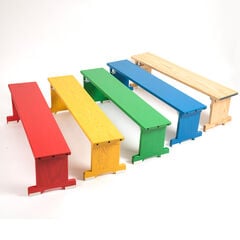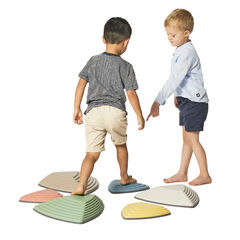Do you remember your own gymnastic lessons back in primary school? What did it look like? Rolling? Leaping? Jumping? Balancing? Making like a tree? Using the equipment?
I can vividly remember Mrs Smithson* my class teacher insisting we climb wall ropes. Now that’s how old I am! The ropes came out from the wall using a pulley and then they all dangled from the ceiling. We would then queue for our turn to climb them. I can still clearly remember watching everyone else shin up and down those ropes like rats up and down drainpipes. Me? Not a chance. Not for a million pounds could I climb a rope. Yes, I could reach and grip with my hands but that was it. My feet would leave the floor as I bent my knees and jumped, but then thudded straight back down again. There was not a sniff of rope climbing ability in me. How humiliating. How dull. I dreaded it. I usually loved PE; I loved the idea gymnastics (I watched it on TV) but I hated the reality of gymnastics at school.
So I look back now and wonder what was Mrs Smithson hoping to gain? Maybe it was simply for me to climb? And of course we need a challenge to make progress, but week in and week out it was never going to happen for me. This challenge was a step too far. There were so many other ways I could climb. I could have climbed over equipment of different heights, low benches, high benches and vaults. I could have climbed through wall bars, on, off and around gym equipment. Now that I could have tried!

Primary Gymnastics – what and why?
Gymnastics offers so many choices of physical actions to teach and learn. It provides a mass of opportunities to explore movements, to test a body’s capabilities, to create movement patterns, to develop sequences, to work with others, to challenge and to succeed. Think about how gymnastics supports development of fundamental movement skills, agility, balance and coordination. These are all features of KS1 and KS2 NC for PE, along with the inclusion of gymnastics itself.
Gymnastics can develop a range of agility skills, including speed and direction of movement along with types of locomotion e.g. leaping, skipping, jumping, running, tiptoeing etc. These can be developed on or off the ground and on or off or around the equipment.
Consider how gymnastics supports the development of our balance and core stability. Every twist, turn, reach, stretch, roll or transfer from ground to feet can all help to develop a strong core which will help control the body.
Coordinating our body parts to be where we want them to be and when we want them to be there can be developed through gymnastics. Don’t forget rhythmic gymnastics too, where object control and hand eye coordination are key.
Remember we are not teaching our pupils to be gymnasts. We are using the power of gymnastic movements to help pupils develop body control and confidence, fluidity of movement, strength, flexibility and timing, along with all the other non-physical outcomes that teaching gymnastics can support. It provides opportunities for paired, small group and individual work, creativity, rhythm, pattern making and sequences. It supports planning, decision making, review and reflection skills. But to engage our pupils it also needs to be enjoyable.
So it can be useful to take a moment to reflect on our teaching of gymnastics. How about mixing gymnastics up a bit?
If we create purposeful learning outcomes, in line with planning and any curriculum mapping, and ensure lessons allow for sequencing between what has been taught before and where the pupils will progress to, we can then get creative!
- I love a bit of music, either in the background to create a positive atmosphere or as a catalyst for movements.
- Our use of equipment can enhance experiences and learning too. Agility and balance can be developed using just the body, but let’s consider some different opportunities to introduce equipment. Try travelling along, forwards, backwards, sideways, include stopping, pausing and balancing on.
- We can use themes, stories and topics to build the teaching of gymnastics around. Oh and I love a word wall supporting learning in PE. Think about all the verbs and adjectives you can use in gymnastics to support learning in English!
- Also consider cross curricular opportunities between gymnastics with science and maths; push and pull, levers, directional language, symmetry, angles.
However we teach gymnastics, take time to reflect and inject something new, something imaginative and be less Mrs Smithson.
A few ideas for you to consider:
- Provide opportunities for simple dynamic and static balance activities using Balance Riverstones or Balance Steps.

- Add in directional travel, using dynamic balance with resources such as a Balancing Snake or simply use flat floor markers or hands and feet floor markers. All of these can create challenge, provide variation and increase enjoyment.

- Coordination can be developed through rhythmic gymnastics themed lessons, using hoops, dance ribbon wands, balls or ropes.
- And let’s not allow Mrs Smithson to put us off using larger equipment. We just need to be mindful of what the desired outcomes of the lessons are and choose equipment accordingly. Whether there is a selection of equipment or access to varying sizes of the same equipment, plan lessons around the learning outcomes and let your creative juices flow.
Explore Gymnastics Equipment and Apparatus
*names have been changed to protect the lover of climbing ropes
Thank you to Philippa Youlden for writing this blog for us.
Philippa Youlden is a freelance PE, sport, wellbeing and education consultant passionate about the power of movement, activity and high quality PE and school sport opportunities for all children. Philippa works nationally delivering CPD, developing educational campaigns and writing resources for a range of organisations and school networks, supporting children to enjoy, thrive and fulfil their potential through PE, sport and physical activity. www.philippayoulden.co.uk
You can also take a look at WELLNESS with Zip Active to support EYFS and KS1 Wellbeing through physical activity, and MOVE with Zip Active supporting EYFS and KS1 fundamental movement skill development and communication and language through movement.










